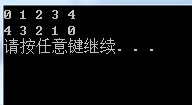集合——set
也就是说set中没有重复元素
构造set集合的主要目的是为了快速检索
另,set是以不连续的节点形式存储的容器(list、set、map)
1.构建
#include<iostream> #include<set> using namespace std; int main() { set<int> s; return 0; }
2.插入元素&&遍历(使用迭代器)
#include<bits/stdc++.h> using namespace std; int main() { set<int>s; for(int i = 0; i < 5; i++) s.insert(i); s.insert(0);//尝试多重复插入元素 set<int>::iterator it;//定义正向迭代器 for(it = s.begin(); it != s.end(); it++) cout << *it << " "; cout << endl; set<int>::reverse_iterator rit; //定义反向迭代器 for(rit = s.rbegin(); rit != s.rend(); rit++) cout << *rit << " "; cout << endl; return 0; }

3.删除
有关erase()函数的使用方法可以看看STL的erase()陷阱-迭代器失效总结这篇文章。
erase会删除这个节点,然后用后面补齐。
4.元素的查找
使用find()方法对集合进行检索,如果找到查找的的键值,则返回该键值的迭代器位置;否则,返回集合最后一个元素后面的一个位置,即end()。
#include<bits/stdc++.h> using namespace std; int main() { set<int>s; for(int i = 0; i < 5; i++) s.insert(i); set<int>::iterator it;//定义正向迭代器 int x; while(cin >> x) { it = s.find(x); if(it != s.end()) cout << "can find" << endl; else cout << "not find" << endl; } return 0; }
count()返回1表示存在,返回0表示不存在
#include<bits/stdc++.h> using namespace std; int main() { set<int>s; for(int i = 0; i < 5; i++) s.insert(i); set<int>::iterator it;//定义正向迭代器 int x; while(cin >> x) { if(s.count(x)) cout<<"can find"<<endl; else cout<<"cant find"<<endl; } return 0; }
5.自定义比较函数
使用insert将元素插入到集合中去的时候,集合会根据设定的比较函数奖该元素放到该放的节点上去。在定义集合的时候,如果没有指定比较函数,那么采用默认的比较函数,即按键值从小到大的顺序插入元素。但在很多情况下,需要自己编写比较函数。
编写比较函数有两种方法。
(1)如果元素不是结构体,那么可以编写比较函数。下面的程序比较规则为按键值从大到小的顺序插入到集合中。
#include<iostream> #include<set> using namespace std; struct mycomp { //自定义比较函数,重载“()”操作符 bool operator() (const int &a, const int &b) { if(a != b) return a > b; else return a > b; } }; int main() { set<int, mycomp> s; //采用比较函数mycomp s.insert(5); //第一次插入5,可以插入 s.insert(1); s.insert(6); s.insert(3); s.insert(5); //第二次插入5,重复元素,不会插入 set<int,mycomp>::iterator it; for(it = s.begin(); it != s.end(); it++) cout << *it << " "; cout << endl; return 0; } /* 运行结果:6 5 3 1 */
(2)如果元素是结构体,那么可以直接把比较函数写在结构体内。
#include<iostream> #include<set> #include<string> using namespace std; struct Info { string name; double score; bool operator < (const Info &a) const // 重载“<”操作符,自定义排序规则 { //按score由大到小排序。如果要由小到大排序,使用“>”即可。 return a.score < score; } }; int main() { set<Info> s; Info info; //插入三个元素 info.name = "Jack"; info.score = 80; s.insert(info); info.name = "Tom"; info.score = 99; s.insert(info); info.name = "Steaven"; info.score = 60; s.insert(info); set<Info>::iterator it; for(it = s.begin(); it != s.end(); it++) cout << (*it).name << " : " << (*it).score << endl; return 0; } /* 运行结果: Tom : 99 Jack : 80 Steaven : 60 */
6.Set常用函数:
c++ stl容器set成员函数:begin()--返回指向第一个元素的迭代器
c++ stl容器set成员函数:clear()--清除所有元素
c++ stl容器set成员函数:count()--返回某个值元素的个数
c++ stl容器set成员函数:empty()--如果集合为空,返回true
c++ stl容器set成员函数:end()--返回指向最后一个元素的迭代器
c++ stl容器set成员函数:equal_range()--返回集合中与给定值相等的上下限的两个迭代器
c++ stl容器set成员函数:erase()--删除集合中的元素
c++ stl容器set成员函数:find()--返回一个指向被查找到元素的迭代器
c++ stl容器set成员函数:get_allocator()--返回集合的分配器
c++ stl容器set成员函数:insert()--在集合中插入元素
c++ stl容器set成员函数:lower_bound()--返回指向大于(或等于)某值的第一个元素的迭代器
c++ stl容器set成员函数:key_comp()--返回一个用于元素间值比较的函数
c++ stl容器set成员函数:max_size()--返回集合能容纳的元素的最大限值
c++ stl容器set成员函数:rbegin()--返回指向集合中最后一个元素的反向迭代器
c++ stl容器set成员函数:rend()--返回指向集合中第一个元素的反向迭代器
c++ stl容器set成员函数:size()--集合中元素的数目
c++ stl容器set成员函数:swap()--交换两个集合变量
c++ stl容器set成员函数:upper_bound()--返回大于某个值元素的迭代器
c++ stl容器set成员函数:value_comp()--返回一个用于比较元素间的值的函数


